Physical Address
304 North Cardinal St.
Dorchester Center, MA 02124
Differences in sex development (DSD) are due to a variety of etiologies, requiring expertise of the pediatric endocrinologist, pediatric urologist, geneticist, and child psychologist, as well as the adolescent gynecologist, cytogeneticist, radiologist, and ethicist in some cases, to aid in the diagnosis, treatment, and optimization of long-term outcomes.
Understanding normal sex development in males and females is critical to determining the cause of DSD.
Genetic testing has advanced our understanding of the origins of sex development, and specific testing may be driven by results of hormonal testing. In other situations, the differential diagnosis for a given condition such as complete gonadal dysgenesis is so large that the use of a DSD panel is necessary. Knowing the genetic diagnosis provides closure for families and identifies other risks associated with the diagnosis, such as recurrence, renal disease, or tumor risk. A genetic diagnosis may also predict outcome at puberty.
For parents of a newborn with genitalia that are not clearly male or female, the ambiguity is a distressing matter that needs to be addressed with sensitivity and some urgency. There are four general classifications that can cause differences in sex development (DSD): (1) androgenization of the 46,XX individual, (2) incomplete androgenization of the 46,XY individual, (3) sex gonadal differentiation and chromosomal disorders, and (4) syndromes associated with incomplete genital development ( Box 85.1 ). The first category, 46,XX DSD, comprises the majority of definable cases of ambiguous genitalia, whereas in the second category, 46,XY DSD, a genetic diagnosis is seen in less than 50% of cases.
Congenital adrenal hyperplasia
21-Hydroxylase deficiency
11-Hydroxylase deficiency
3β-Hydroxysteroid dehydrogenase deficiency
P450 oxidoreductase deficiency
Aromatase deficiency (fetal and maternal virilization)
Virilizing maternal conditions
Ovotesticular disorder of sex development
Adrenal/ovarian tumors/luteoma of pregnancy
Maternal ingestion of progestins, androgens
Androgen insensitivity
Complete
Partial
5α-Reductase type 2 deficiency
Testosterone biosynthetic defects
Steroidogenic acute regulatory (StAR) deficiency
P450 side chain cleavage enzyme deficiency
17α-Hydroxylase/17,20-lyase deficiency
P450 oxidoreductase deficiency
3β-Hydroxysteroid dehydrogenase deficiency
17β-Hydroxysteroid hydrogenase type 3 deficiency
Leydig cell hypoplasia
Idiopathic, undetermined
Drug ingestion: progestins, spironolactone, cimetidine, phenytoin
Persistent müllerian duct syndrome
46,XY gonadal dysgenesis
Complete (Swyer syndrome)
Partial
Mixed (45,X/46,XY)
Ovotesticular disorder of sex development
46,XX, 46,XY, 45X/46XY, 46,XX/46,XY
Gonadal dysgenesis
45,X/46,XY mixed gonadal dysgenesis (Turner syndrome features)
Campomelic dysplasia
Renal degenerative diseases and gonadal dysgenesis
Denys-Drash syndrome
Frasier syndrome
WAGR (Wilms tumor, aniridia, genitourinary abnormalities, mental retardation) syndrome
Smith-Lemli-Opitz syndrome (7-dehydrocholesterol reductase deficiency)
Robinow syndrome
This chapter presents an overview of the pathophysiology of DSD, including a discussion of the practical aspects of diagnosis and management. An overview of the traditional surgical methods used in the treatment of infants with DSD, including the risks and benefits of these procedures, is included at the end of the chapter.
The medical evaluation of a newborn with ambiguous genitalia is necessarily time consuming. Open and honest discussions with the parents are invaluable in allaying anxiety and establishing a trusting relationship. Full disclosure of available information is essential in this regard.
Care must be taken to avoid premature sex assignment for the infant. Proper evaluation of the infant with ambiguous genitalia requires a multidisciplinary team that should include the primary care physician, neonatologist, pediatric endocrinologist, psychologist, pediatric urologist, pediatric geneticist, and pediatric radiologist. Psychological assessment and support of the family are essential in the newborn period, along with long-term psychological follow-up evaluation. Decisions regarding the sex of rearing should be made collaboratively between the multidisciplinary team and the parents, with the recognition that cultural and psychosocial factors play a role.
In the past, sex assignment was based largely on clitoral-phallic size, relative ease of surgical reconstruction, or the potential for fertility. This approach has come under criticism as dissatisfaction with sex assignment based on these criteria has been reported in several case studies. The importance of prenatal androgen imprinting has been implicated as an important variable in some of these cases. Studies in 46,XY males with incomplete androgenization indicate that a small phallus can be associated with a satisfying adult sex life. Other studies have found that gender role tends to increasingly correspond with assigned sex as individuals with DSD proceed into adulthood ; therefore, female sex assignment might not be necessarily warranted for 46,XY males with partially incomplete androgenization.
The degree of genital androgenization is one determinant of sex assignment in the infant with ambiguous genitalia; however, other factors such as chromosome complement and etiology of the DSD also play an important role. Parents need to understand that only a sex of rearing is being assigned. It will be up to the individual to choose their gender identity. The formation of a healthy gender identity seems to involve a complex interplay between psychobiologic and environmental factors. Today with the increased awareness of gender dysphoria, these individuals will have an easier time confirming their own gender identity, even if it is different from the chosen sex of rearing.
Normal and abnormal sex determination and differentiation constitute superb examples of how an understanding of embryology is critical to the approach and management of a group of complex and intriguing clinical disorders. Development of the testis and ovary is unique compared with the development of other organs in that they both derive from the same bipotential gonad. The establishment of a testis or an ovary depends on which pathway is taken based on the genetic background. In the past, the ovarian pathway was thought to be the default pathway. However, from studies of individuals with DSD, it is now known that ovarian development is an active process, and certain genes must be present for the ovary to develop.
Sex determination and differentiation are sequential processes that can be divided into three stages, with the sequence as follows: chromosomal sex is determined at fertilization and dictates the differentiation of the bipotential gonad, which in turn dictates the phenotypic sex, or the differentiation of the internal ductal system and external genitalia on the basis of which hormones are produced by the gonad.
Chromosomal sex is determined at the moment of conception by the sex chromosome complement of the fertilizing sperm. If this sperm carries an X chromosome, a 46,XX (normal female) complement results. If the sex chromosome is Y, a 46,XY (normal male) genotype results. The SRY (s ex-determining r egion of the Y chromosome) gene is necessary but not sufficient for testicular differentiation. Other autosomal and X chromosomal genes are also necessary for male sex development. SRY is, however, the only gene on the Y chromosome involved in testicular determination and differentiation. SRY, through a number of steps, instructs the medullary region of the bipotential gonad to develop into Sertoli cells and later into testicular cords and seminiferous tubules. SRY continues to be expressed at low levels in Sertoli cells until adulthood.
In addition to X chromosomal genes, autosomal genes influence sex differentiation insofar as mutations of these genes result in disorders of sex differentiation. Some of these genes include WT1 ( W ilms t umor gene 1 ), associated with Denys-Drash syndrome and WAGR ( W ilms tumor, a niridia, g enitourinary abnormalities, mental r etardation) syndrome; NR5A1 ( n uclear r eceptor subfamily 5 , group A , member 1 ), which encodes steroidogenic factor 1; and SOX9 , which has been associated with campomelic dysplasia and testicular dysgenesis in 75% of XY individuals. SOX 9 expression is upregulated by SRY. The DMRT1 and DMRT3 genes on chromosome arm 9p, when deleted, are associated with female development in an XY individual. More recently, a de novo missense mutation in DMRT1 was identified in a female with 46,XY karyotype, providing evidence that DMRT1 is the critical gene for testicular differentiation. The FOXL2 gene is expressed in fetal and adult ovarian follicular cells and is critical to ovarian development, fertility, and maintenance of the ovary. It is also expressed in eyelids, with mutations leading to blepharophimosis–ptosis–epicanthus inversus syndrome, and is located within the homologous region in the human at 3q23. The DAX1 gene is located on Xp22 and appears to be necessary for correct testis determination and, in the mouse at least, necessary for the upregulation of Sox9 expression. When the DAX1 gene is duplicated, 46,XY individuals develop gonadal dysgenesis with a female phenotype. The WNT4 gene is critical for normal ovarian and female sexual development. A mutation in WNT4 leads to müllerian duct regression and virilization in a 46,XX female, whereas duplication of the locus containing WNT4 leads to overexpression of DAX1 and thus a 46,XY female phenotype. The desert hedgehog gene ( DHH ) is a member of a family of signaling genes with an important role in regulating morphogenesis. The follistatin gene ( Fst ) and the bone morphogenetic protein 2 gene ( Bmp2 ) appear to be important for ovary organogenesis in mice. Mutations in Gata4 or Fog2 can cause sex reversal in mice. In humans, GATA4 is a transcription factor necessary for genital ridge formation, testicular and ovarian differentiation, and male and female fertility. GATA4 interacts with multiple genes, such as SRY , SOX9 , and AMH , as well as others involved in hormonal synthesis. GATA4 acts synergistically with NR5A1 to activate the AMH promoter, and a mutation in GATA4 led to the lack of this synergy with NR5A1 as well as inability for FOG2 to bind to GATA4, resulting in familial 46,XY DSD and congenital heart defects. FOG2 modifies GATA4 activity by binding to GATA4's zinc finger. Missense mutations in FOG2 have been identified in two individuals with 46,XY gonadal dysgenesis. The pathways to testicular and ovarian development are illustrated in Fig. 85.1 .
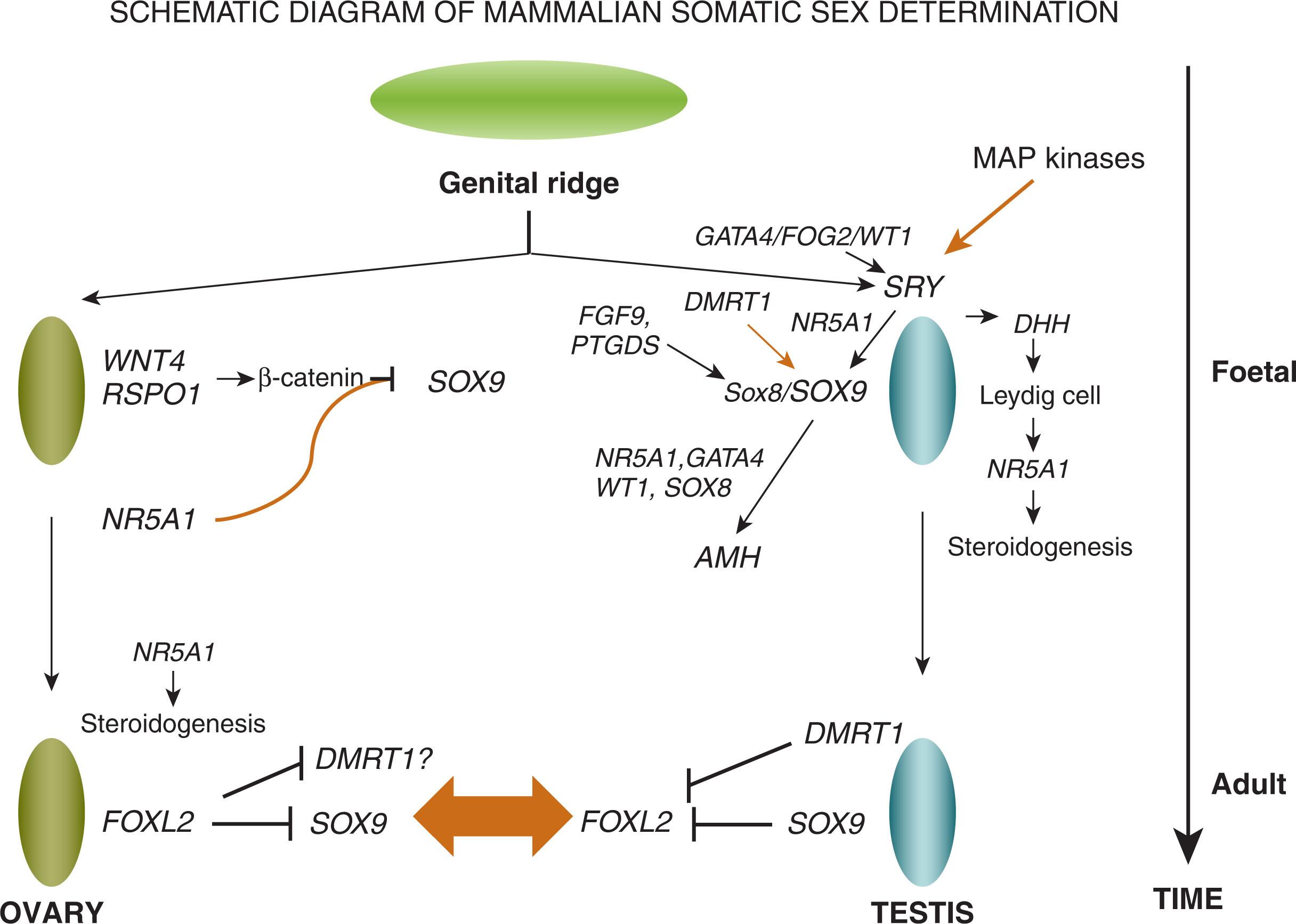
The gonad develops from both somatic and germ cells. The somatic cells are located at the ventral region of the mesonephros and arise from the mesonephric cells and the coelomic epithelium. Somatic cells become the Sertoli cells of the testis and the granulosa cells of the ovary. The germ cells migrate from a more inferior position on the yolk sac to the genital ridge, just medial to the mesonephros on each side ( Fig. 85.2 , upper left). This migration occurs between 4- and 6-weeks’ gestation. Once the germ cells reach the gonadal ridge, they become surrounded by the somatic cells, which appear to regulate germ cell differentiation.
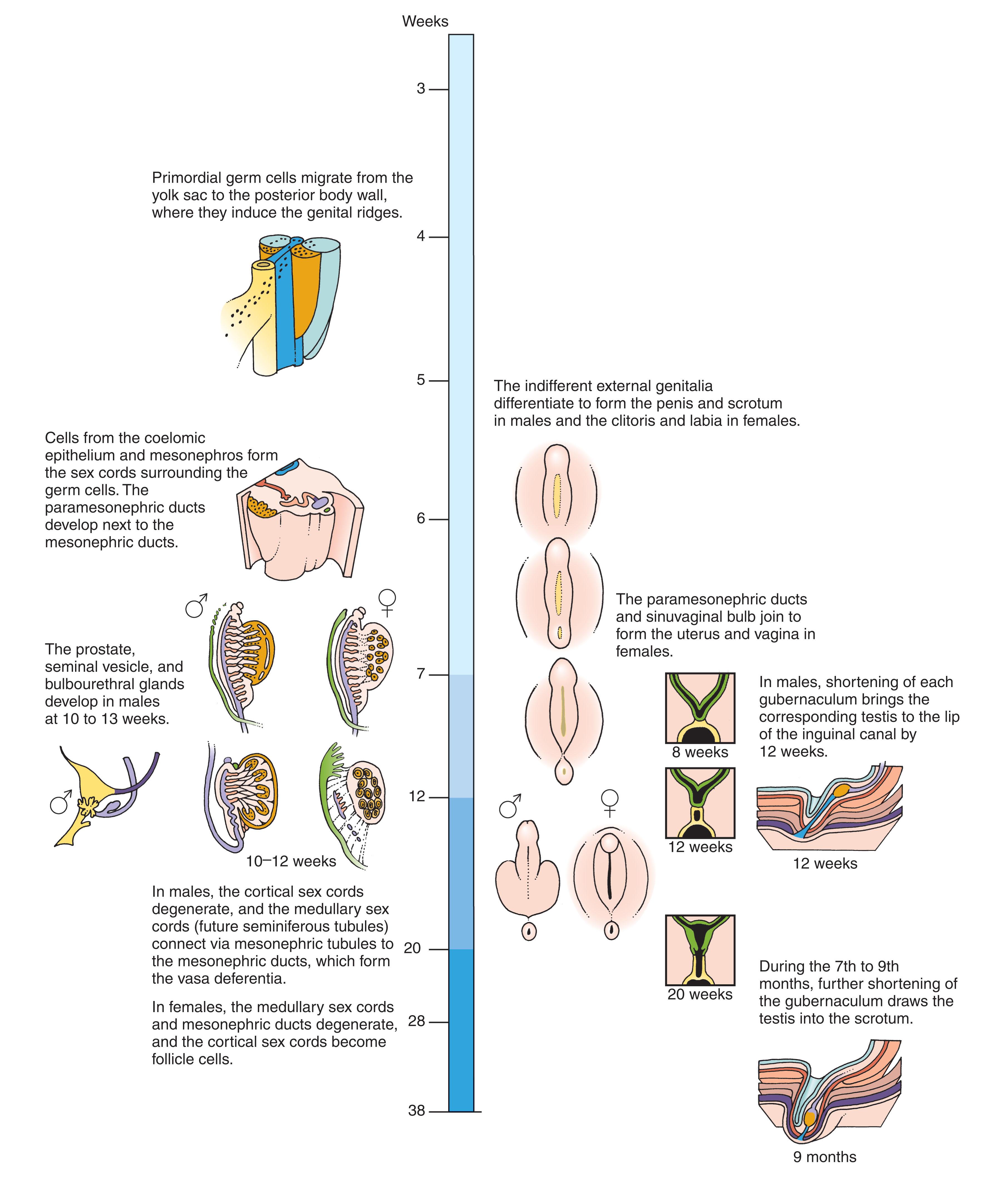
Gonadal sex is established by 7 weeks’ gestation. At this stage the fetus contains two parallel internal ductal systems—wolffian and müllerian—and undifferentiated external genital primordia. The wolffian, or mesonephric, duct is a tubular structure that connects the capillary network of the mesonephros to the urogenital sinus. Evagination of the coelomic epithelium leads to formation of a second tubular structure adjacent to the mesonephric duct—the paramesonephric, or müllerian, duct. The distal ends of these two ducts are joined. That portion of the urogenital sinus distal to the termination of these ducts contributes to external genital development, whereas the proximal portion develops into the bladder, trigone, and posterior urethra.
Phenotypic sexual differentiation is predicated on establishing gonadal sex. If an ovary develops, the wolffian ducts involute because of a lack of local testosterone exposure, and only the terminal portion persists as a Gartner duct. In the absence of anti-müllerian hormone (AMH), a glycoprotein secreted by the fetal Sertoli cells, the müllerian ducts develop into the proximal portion of the vagina, uterus, and fallopian tubes (see Fig. 85.2 ). The unfused cephalic portions of the müllerian ducts form the fallopian tubes, whereas the caudal ends fuse to form the ureterovaginal canal (see Fig. 85.2 ). The union of the fused caudal ends of the müllerian ducts and urogenital sinus forms the vagina. Thus, the proximal two-thirds of the vagina is of müllerian duct origin, and the distal third is of urogenital sinus origin. There is no fusion of the labioscrotal folds and no increase in clitoral–phallic structure in the absence of elevated levels of circulating androgens.
Male phenotypic differentiation is the result of the elaboration of two distinct testicular hormones: testosterone and AMH. These factors are produced and secreted by the 8-week stage of development, and they are essential for normal male differentiation. Involution of the müllerian ducts is caused by AMH. The remnants of the müllerian ducts persist caudally as the prostatic utricle and cephalically as the appendix testis. AMH exerts its action unilaterally and locally (exocrine secretion) rather than bilaterally via the systemic circulation.
Immediately after müllerian duct regression, the wolffian ducts develop under the local influence of testosterone secreted by the fetal Leydig cells. The Leydig cells, like the Sertoli cells, differentiate from the mesenchymal cells within the gonadal ridges; this occurs at 9 to 10 weeks' gestation. Under the influence of testosterone, the wolffian ducts evolve into the epididymis, vas deferens, and seminal vesicles (see Fig. 85.2 ). The mesonephric tubules develop into the ductuli efferentes, which will provide continuity between the seminiferous tubules and rete testis to the vas deferens. This process occurs as a direct action of local testosterone on the ductal structures. Elevated serum testosterone levels such as seen in congenital adrenal hyperplasia due to 21-hydroxylase deficiency in females do not cause wolffian duct stabilization.
Androgenization of the male external genitalia, fusion of labioscrotal folds, and movement of the urethral opening, starts at approximately 8 weeks' gestation (see Fig. 85.2 ). Androgenization relies on the ability of the tissues involved to convert testosterone into a more potent androgen: dihydrotestosterone (DHT). The target cells possess the enzyme 5α-reductase type 2, which is necessary for this conversion. In addition, an intact androgen receptor is necessary for the androgenization of the male external genitalia. By 12 to 14 weeks' gestation, formation of the male external genitalia is nearly complete. Androgen exposure after this time results in further phallic enlargement. Initially, testes are stimulated to make testosterone by maternal HCG during the first trimester but by 16 to 20 weeks’ gestation, the fetus’ own luteinizing hormone (LH) is driving testosterone production.
Testicular descent occurs in two stages. The initial transabdominal descent occurs at 8 to 15 weeks and depends on insulin-like 3 (INSL3) and its G protein–coupled receptor (GREAT) which are secreted by the testes. Other testicular factors likely also play a role, as most dysgenetic gonads are intraabdominal. Descent into the inguinoscrotal region occurs at 25 to 35 weeks and is androgen dependent.
A detailed family history is important in the evaluation of ambiguous genitalia. Information on early neonatal deaths, consanguinity, or urogenital anomalies should be obtained. A family history of female infertility, amenorrhea, or müllerian duct abnormalities can be suggestive of a DSD. In one study of androgen insensitivity disorders that are X-linked, a positive family history of a sex differentiation disorder was often overlooked.
The presence of maternal androgenization is suggestive of a variety of disorders that can affect the androgenization of the fetus. Features of maternal androgenization include hirsutism, severe acne, deepening of the voice, and clitoromegaly.
The ingestion of any recreational drugs, alcohol, or medications by the mother during pregnancy should be noted. Particular attention to medications with androgenic or progestational activity is indicated. Medications that affect fetal genital development include cimetidine, spironolactone, hydantoin, and progestational agents. Maternal retention of progesterone-secreting intrauterine devices at the time of conception have also been associated with androgenization of a female fetus. Progestational agents are used in assisted reproductive technology to support the pregnancy in the first trimester; therefore, asking if the pregnancy was conceived spontaneously or through the use of assisted reproductive technology is important.
There is significant overlap of the genital anatomy among the various sex differentiation disorders. The physical examination, however, can provide the first clues to the underlying disorder. In addition, the physical examination will provide important information about the degree of androgenization of the external genitalia and the presence or absence of palpable gonads. Prader stage ( Fig. 85.3A ) is used to describe the androgenization of female external genitalia. The external masculinization score (see Fig. 85.3B ) is used to describe the incomplete androgenization of male external genitalia. The physical examination will also inform the examiner as to when the DSD occurred in fetal life.
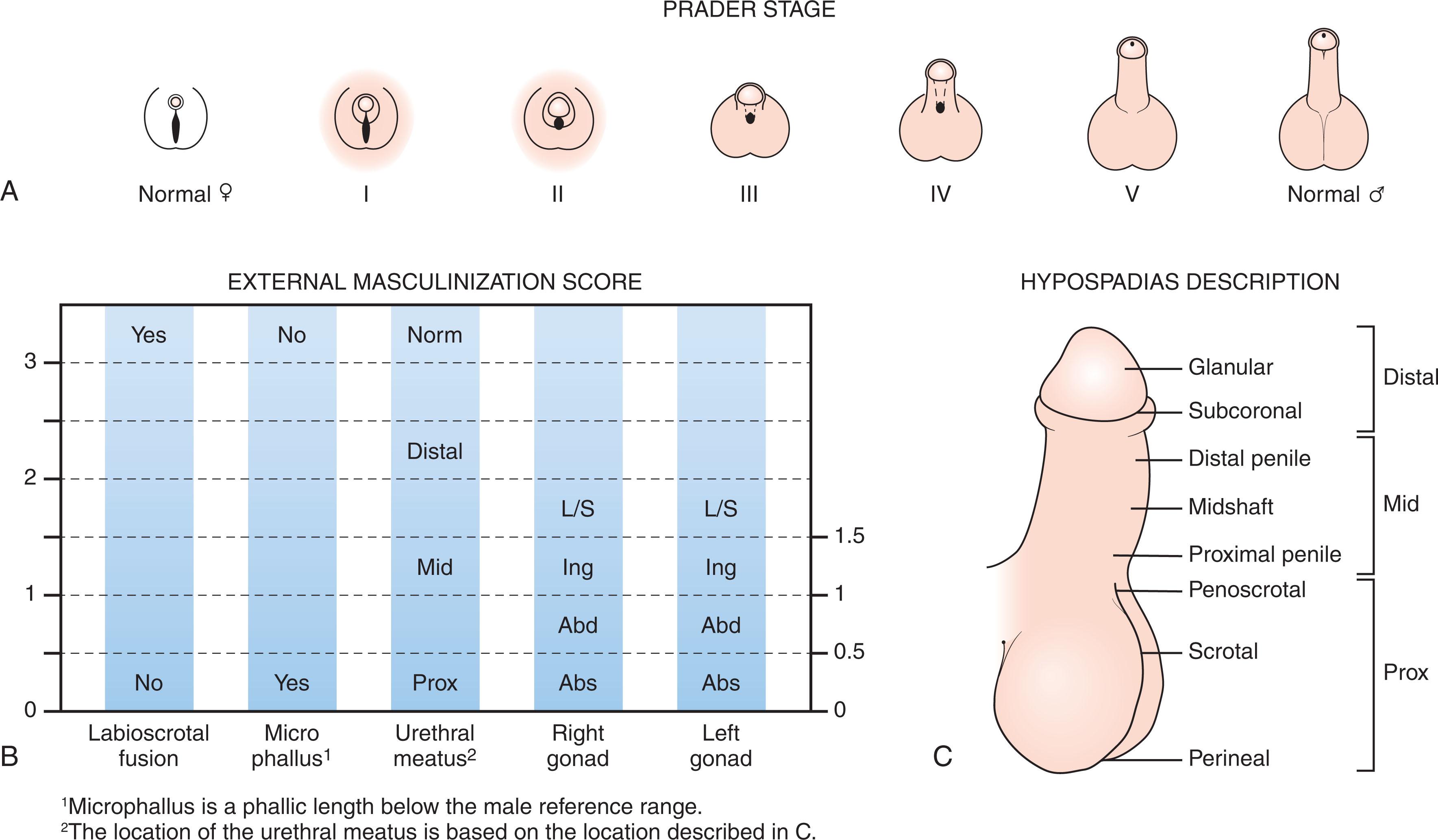
Significant clitoral enlargement deserves careful evaluation. A point to keep in mind is that premature infants have relatively underdeveloped labia majora, so the clitoris may appear enlarged. A truly enlarged clitoris can be distinguished from a large clitoral hood by the presence of palpable corporal or erectile tissue.
Measurements of the phallic stretch length and middle shaft diameter are important in determining the degree of virilization. The phallus should be stretched and measured from the pubic ramus to the tip of the glans. Gestational age–corrected phallic stretch lengths are shown in Fig. 85.4 . The presence of a chordee structure on the ventral surface of the phallus can impair measurement of the true phallic length ( Fig. 85.5 ). Chordee is the result of residual urethral tissue that continues to tether the phallus to the perineum. Measurement of the middle shaft diameter is particularly useful in this circumstance. For term male infants, a normal middle shaft diameter is approximately 1 cm.
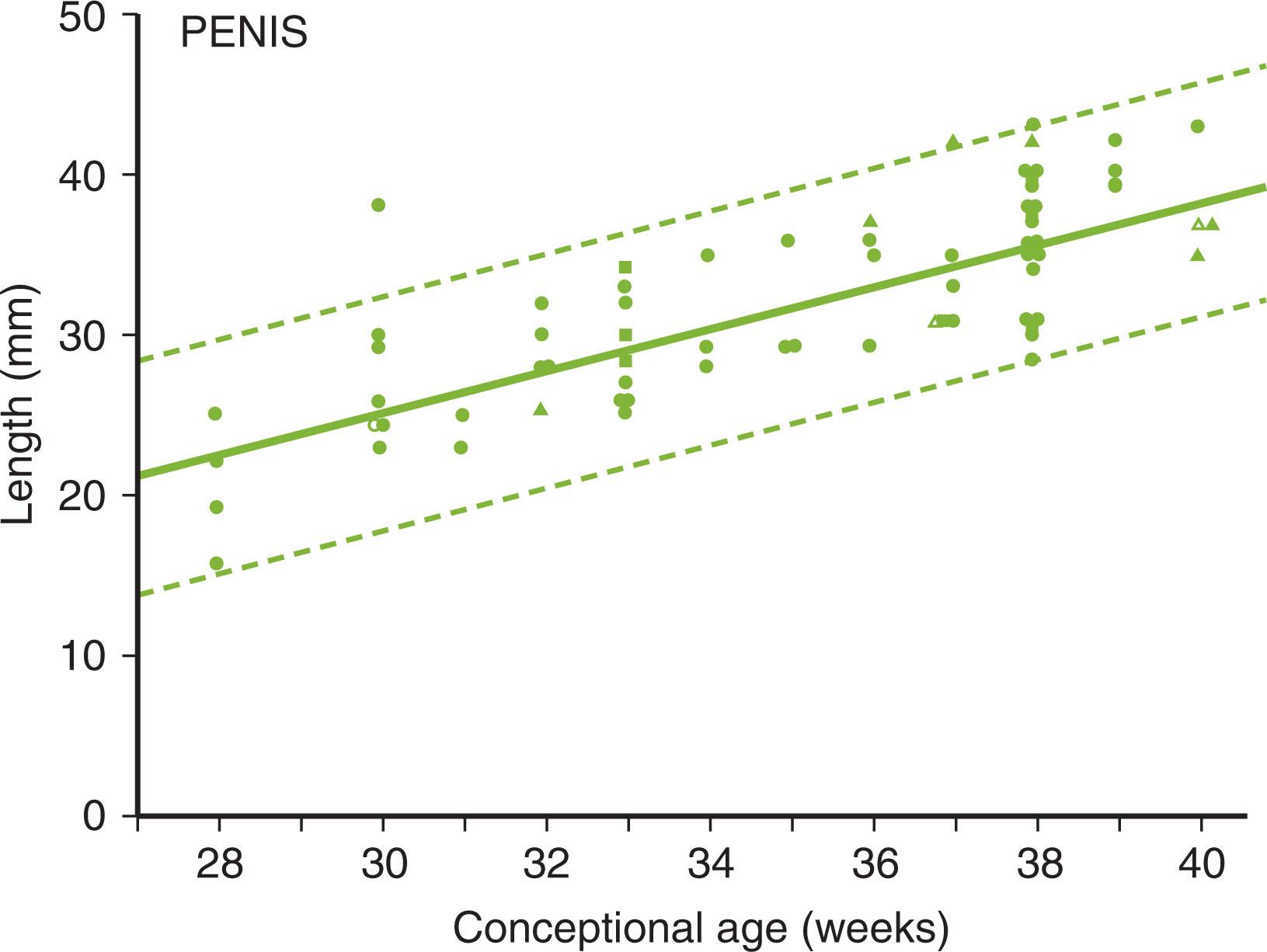
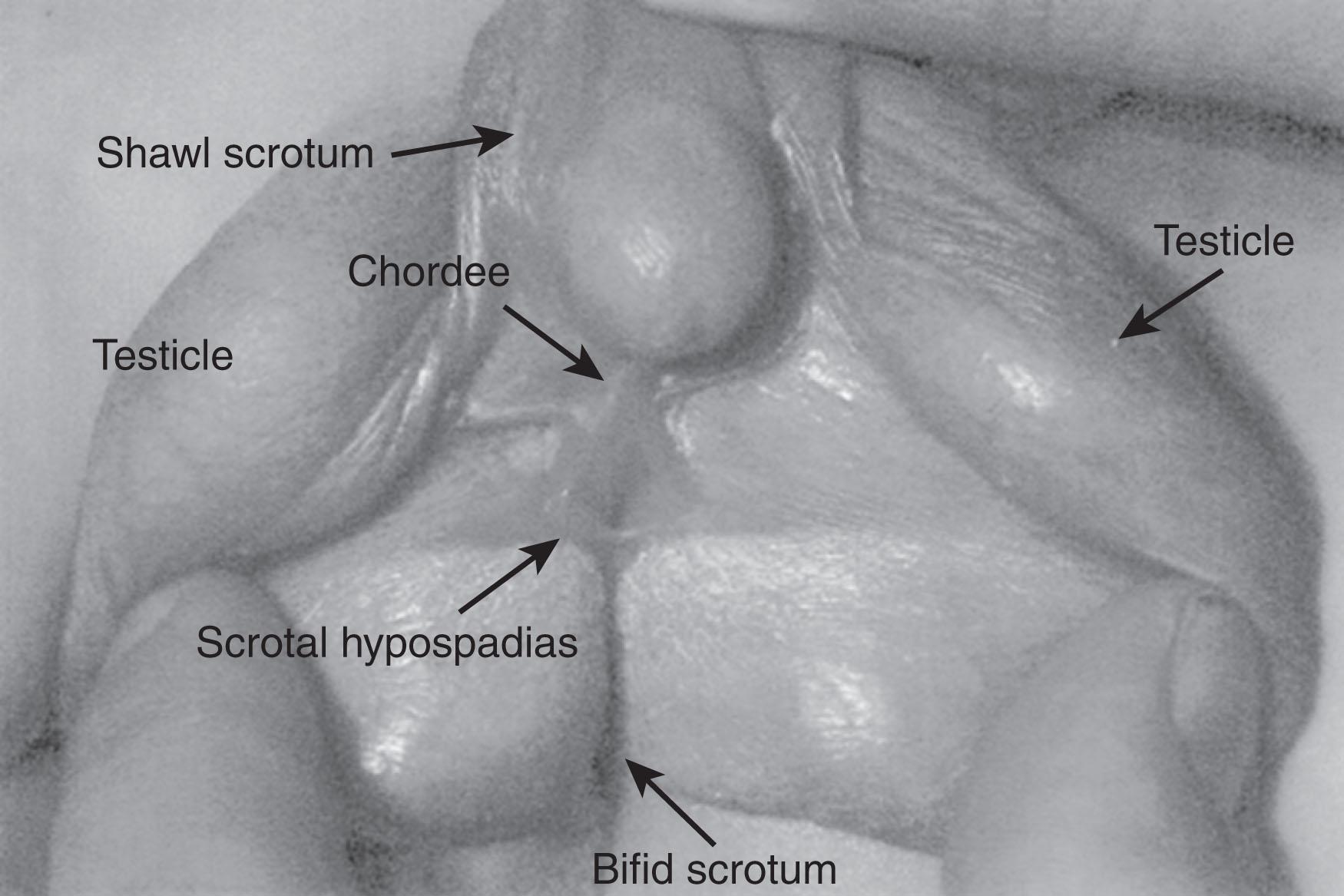
An isolated microphallus warrants careful evaluation for the presence of hypopituitarism (gonadotropin, ACTH, TSH, or growth hormone deficiency), particularly in the presence of hypoglycemia or unexplained jaundice. Microphallus and undescended testes may occasionally be the presenting phenotype for a DSD.
In neonates with ambiguous genitalia, assessment of the degree of fusion of the labioscrotal folds should be performed. When the infant is exposed to androgens during embryogenesis, fusion of the labioscrotal folds progresses from a posterior to an anterior direction. The spectrum of labial fusion can range from mild posterior fusion to complete labial fusion ( Fig. 85.6 ). Fusion of the labioscrotal folds occurs in the first trimester. The examiner should note whether the folds are rugated or hyperpigmented. Is the phallus positioned in the normal superior position relative to the scrotum, or is there a shawl scrotum (penoscrotal transposition)? Is the scrotum fused normally in the midline, or is the scrotum bifid (see Fig. 85.5 )?
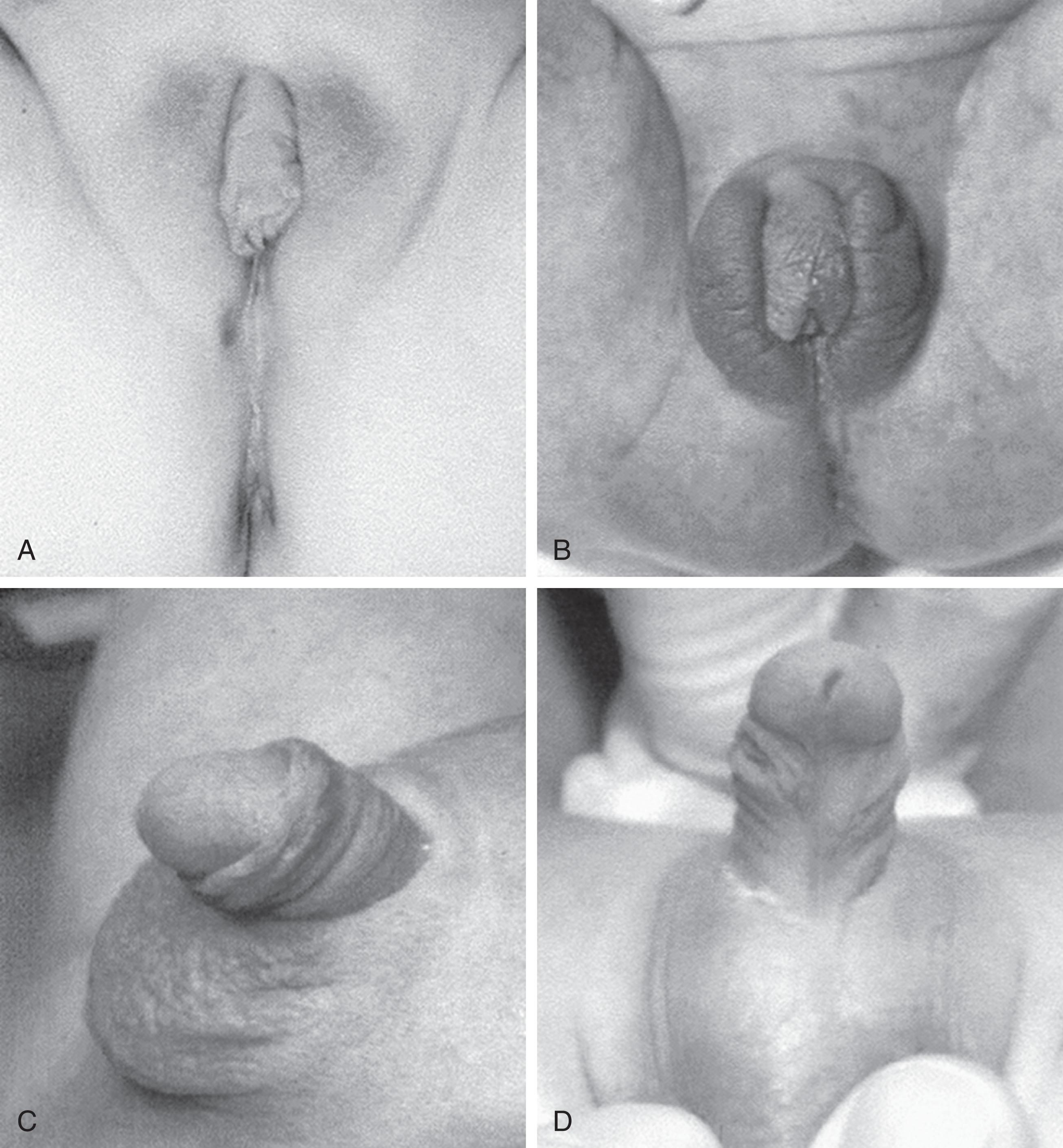
Careful examination for the presence of gonads should be performed in all infants with ambiguous genitalia. The presence of bilateral gonads in the labial folds is highly suggestive of a genetic male with incomplete androgenization (see Fig. 85.5 ). A unilaterally palpable gonad is often seen in infants with mixed gonad dysgenesis or ovotesticular DSD ( Fig. 85.7 ), although other disorders such as androgen insensitivity can manifest themselves similarly. When cryptorchidism and hypospadias occur simultaneously, there is a greater than 25% chance of a DSD.
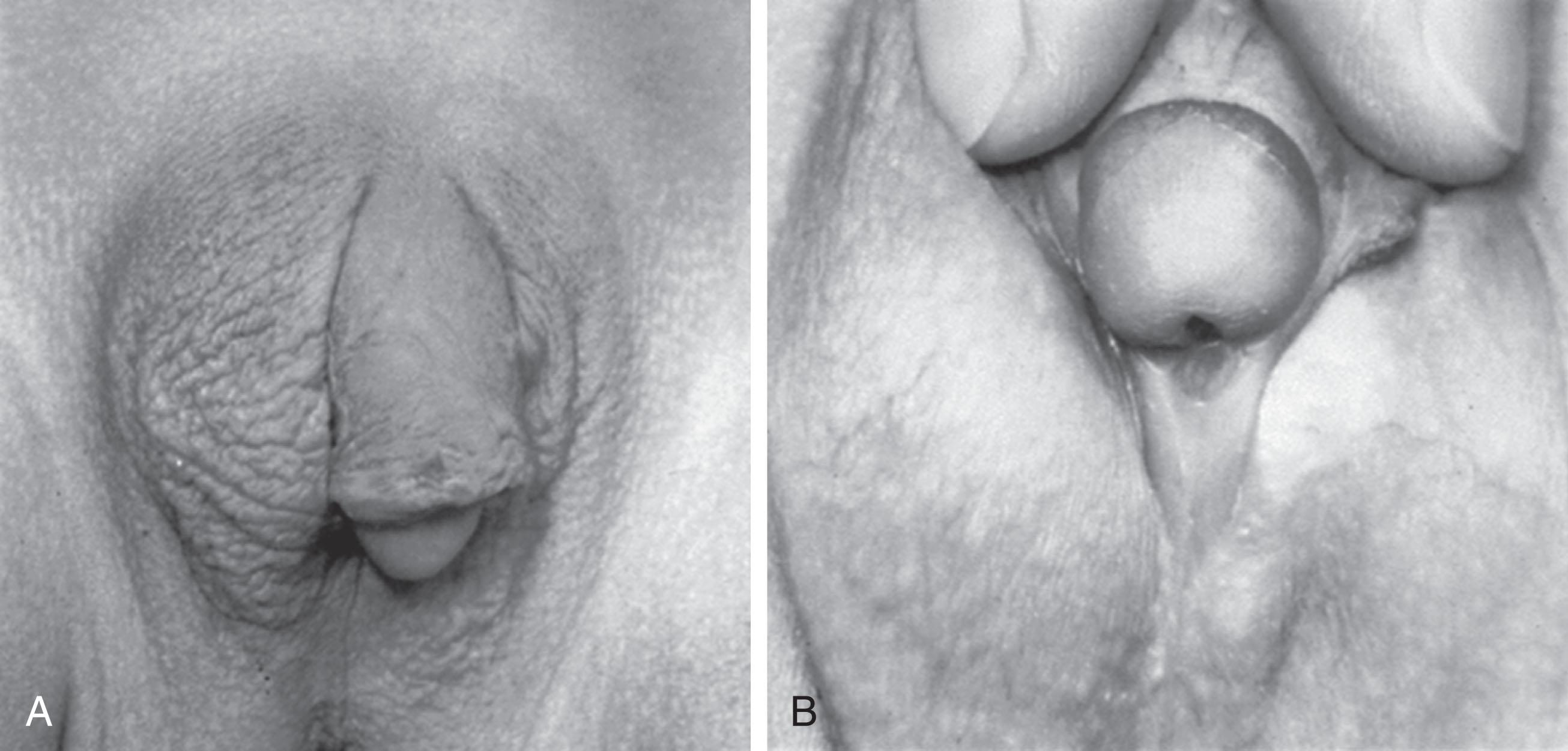
The severity of hypospadias can differ, with the condition ranging from mild glanular hypospadias to penoscrotal hypospadias (see Fig. 85.3C ), although most disorders of sexual differentiation manifest themselves with severe penoscrotal or scrotal hypospadias (see Fig. 85.5 ). Examination for the presence of separate urethral and vaginal openings versus a single perineal opening (urogenital sinus) conveys important anatomic information. The vagina may be blind ending or completely formed. A urogenital sinus results from failure of the urologic and genital tracts to differentiate completely. In females exposed to androgens, the level at which the vagina enters the sinus (low-level versus high-level vaginal entry) has important implications for determining the ease of subsequent surgical exteriorization of the vagina ( Fig. 85.8 ). In addition, when the urethra enters a urogenital sinus, there is potential for urinary stasis and therefore urinary tract infections. Excessive pigmentation of the genitals or signs of dehydration should alert the examiner to the possibility of congenital adrenal hyperplasia (CAH).
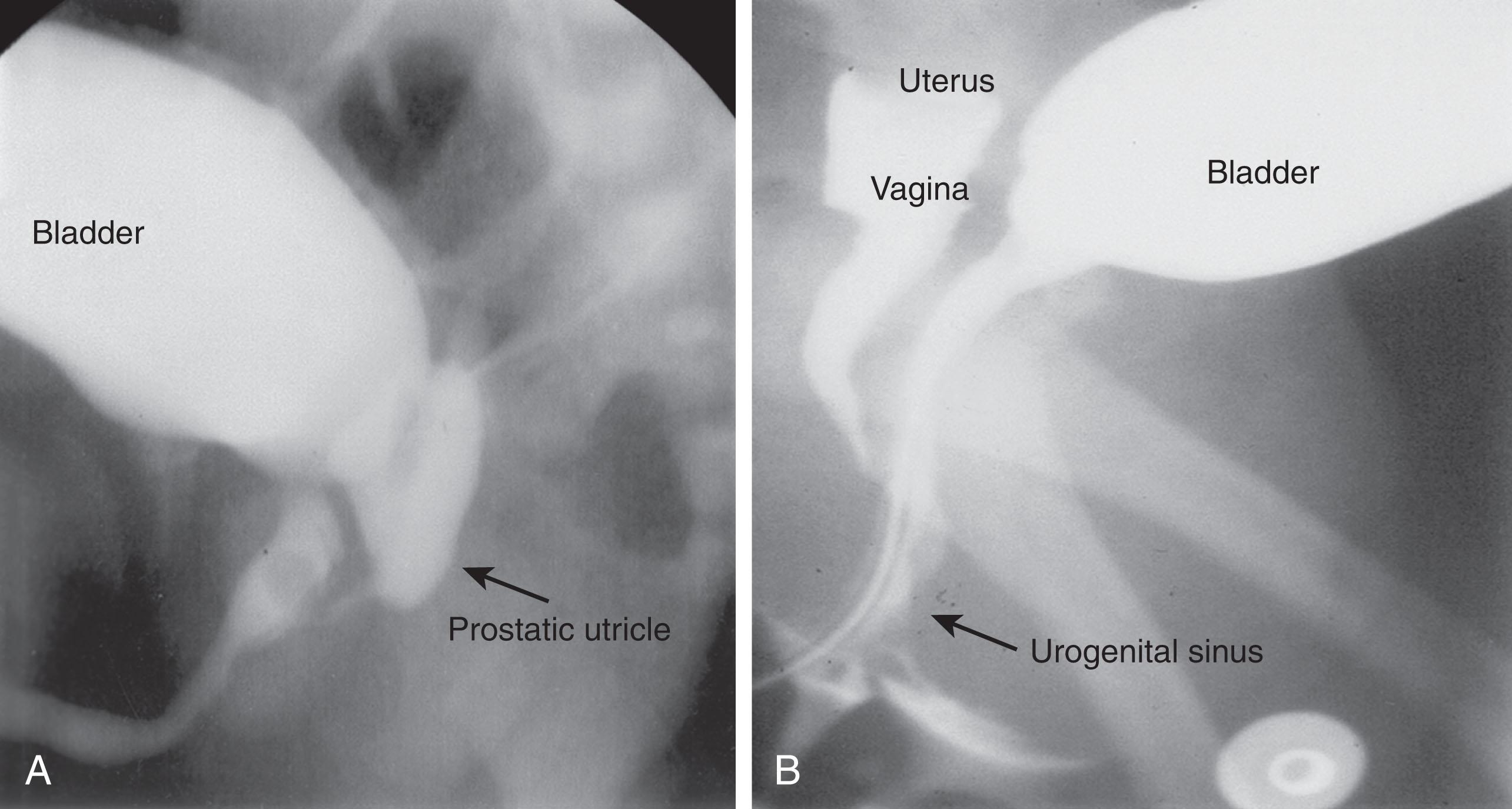
Dysmorphic features suggestive of Turner syndrome indicate the possibility of gonadal dysgenesis or mixed gonadal dysgenesis. Such abnormalities or multiple congenital anomalies could indicate any of a variety of syndromes associated with ambiguous genitalia (see Box 85.1 ).
Pelvic ultrasonography reveals vital information in the evaluation of DSDs. The presence or absence of a uterus is a critically important determinant in the initial evaluation ( Figs. 85.9–85.11 ). The newborn period is a time when the uterus, ovaries, and adrenal glands are optimally visualized. The presence of a well-developed uterus will direct the differential diagnosis toward a condition leading to androgenization of a genetic female’s external genitalia, 46,XY ovotesticular DSD, 46,XY complete gonadal dysgenesis, or persistent müllerian duct syndrome (PMDS); however, only a rudimentary uterus may be seen in 46,XY gonadal dysgenesis or ovotesticular DSD. Importantly, the inability to identify a uterus on ultrasound is not conclusive for lack of a uterus. Ultrasonography for testes location has sensitivity and specificity of 45% and 78% and is not recommended per current American Urologic Association (AUA) guidelines. Ultrasound examination can determine whether the adrenal glands appear enlarged, as in CAH; however, normal adrenal size does not rule out CAH.
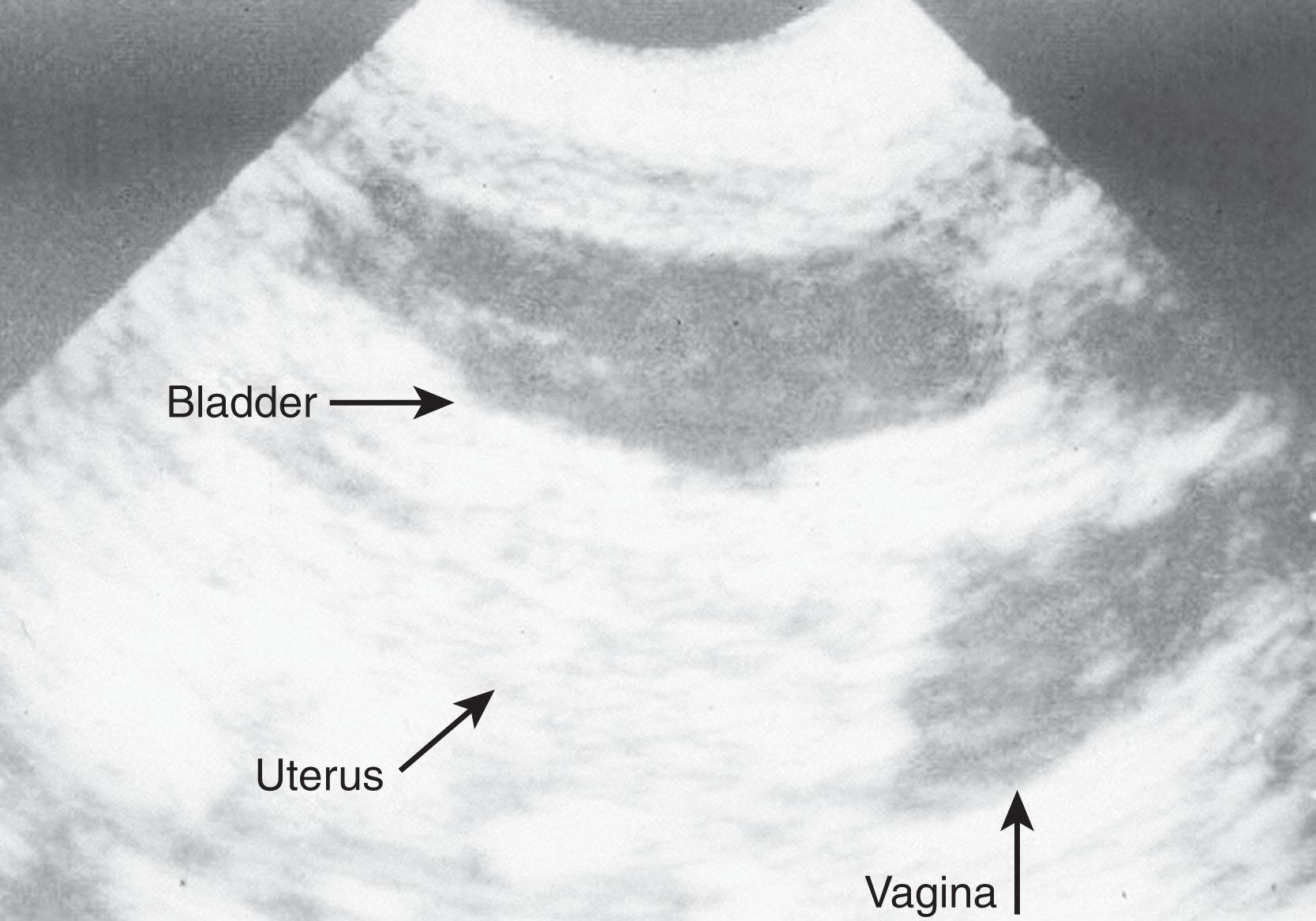
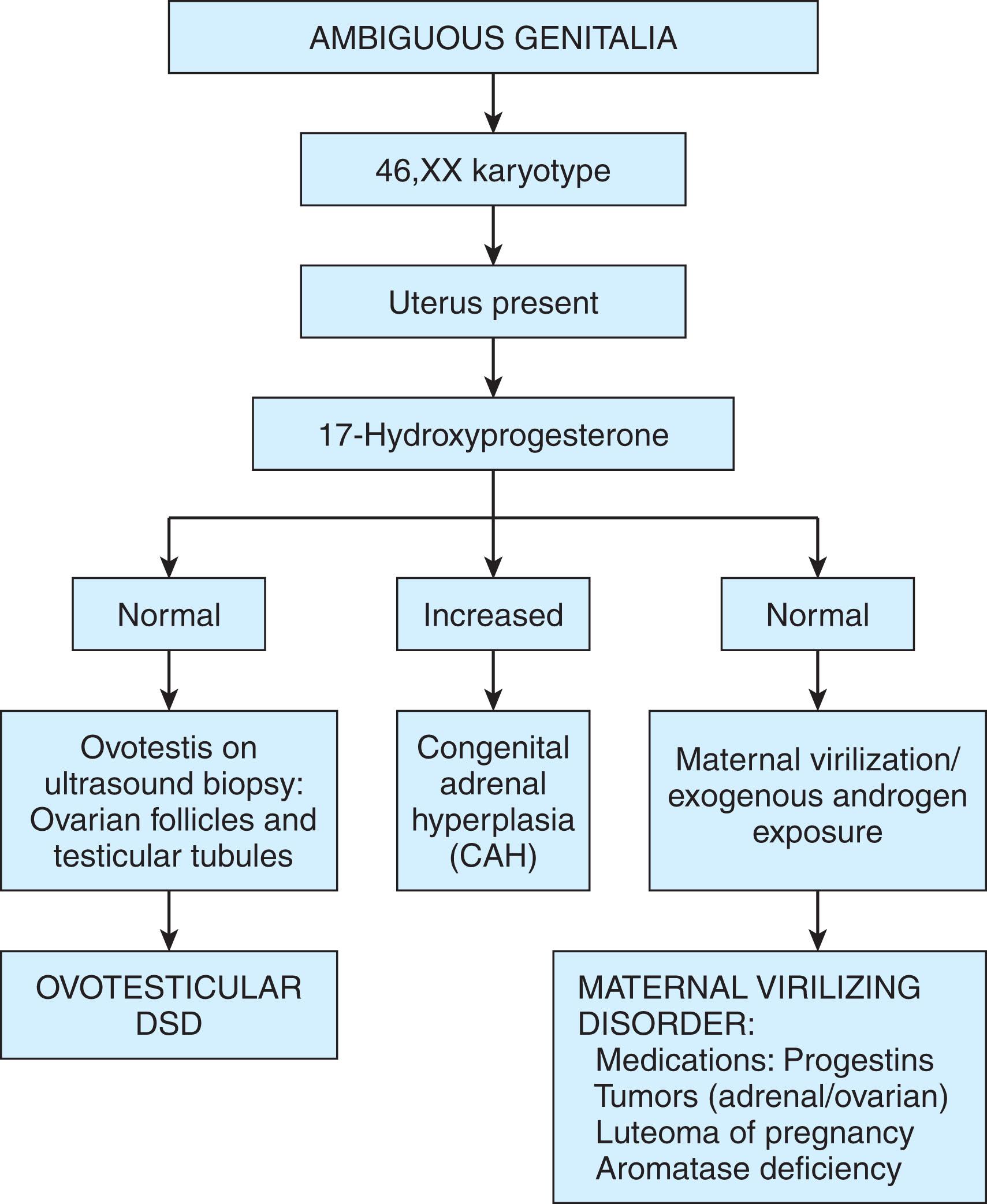
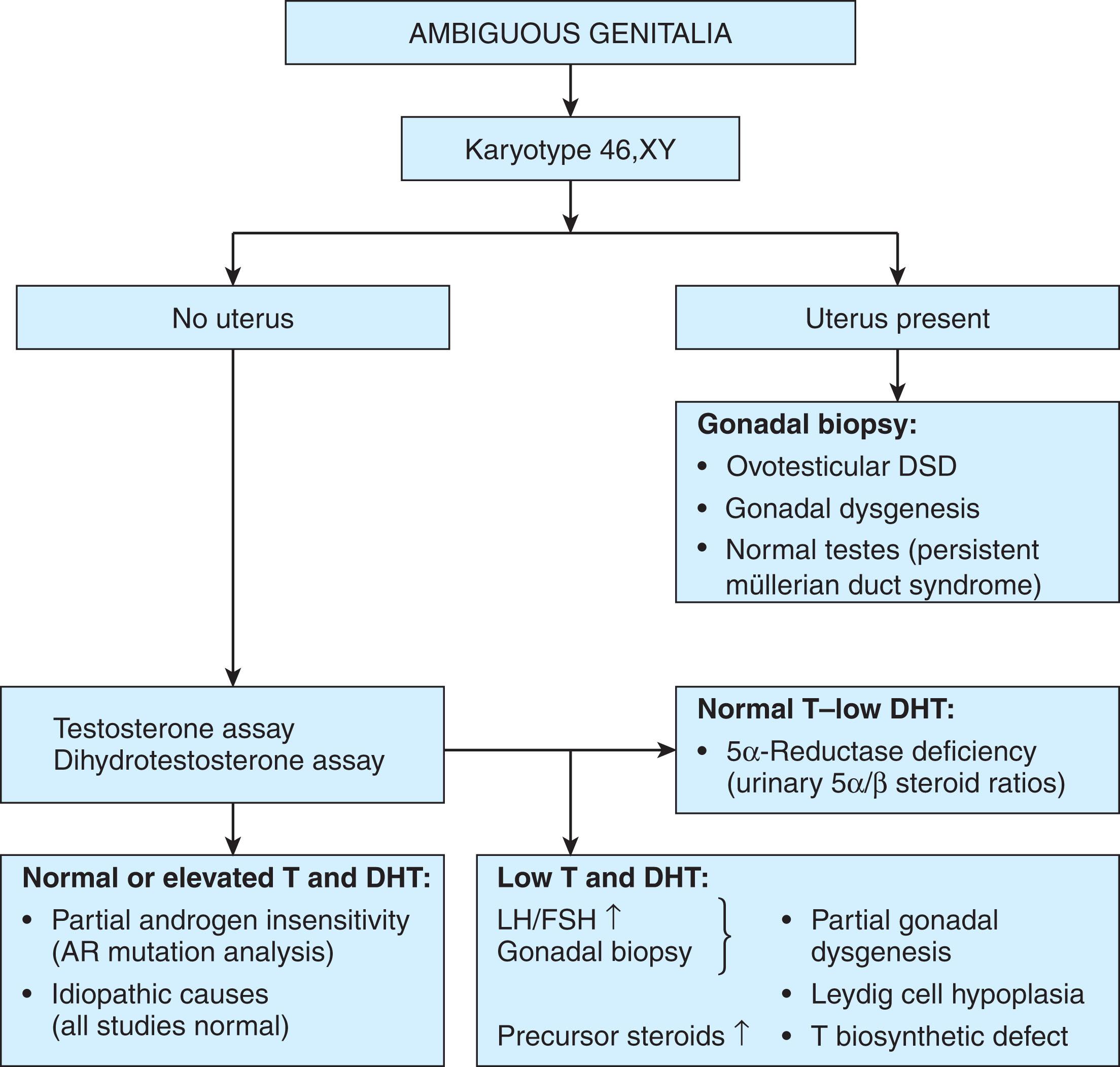
A genitourethrogram is a fluoroscopically-guided genital dye study that can provide important information on the urethra and internal genital ducts. An experienced radiologist should perform this study. It is important to ensure that all perineal orifices are examined. The main features to be noted are the presence or absence of a vagina (or prostatic utricle) and the relationship between the vagina and the urethra (see Fig. 85.8 ). Demonstration of the level at which the vagina opens into the urogenital sinus and its relationship to the external sphincter has important surgical implications. Recognition of male or female urethral configurations may also be possible during genitourethrography.
Magnetic resonance imaging (MRI) has been used to assess the internal genitalia of a limited number of infants and children with genital differentiation disorders. The strength of MRI lies in its ability to image large areas in multiple planes and characterize soft tissues. Detailed information about müllerian and wolffian structures and the position of the gonads can be obtained; however, thin sections (3 to 5 mm) are required for an adequate study. Streak gonads remain difficult to visualize. MRI has the capability to differentiate between an enlarged clitoris and a penis, because the bulbospongiosus muscle and transverse perineal muscle are absent or poorly visualized in the virilized female. MRI is a promising modality for the evaluation of ambiguous genitalia as it offers greater sensitivity and specificity than other studies, but it is more expensive, and anesthesia may be required.
Endocrine and genetic laboratory studies are germane in the evaluation of ambiguous genitalia in the newborn. Day 1 of life is an ideal time to obtain serum testosterone and dihydrotestosterone (DHT) levels by liquid chromatography—tandem mass spectrometry (LC–MS/MS), as testosterone levels fall rapidly in the first several days of life. It is important to use LC–MS/MS assays as other assays measure interfering substances that will falsely elevate the testosterone level. Chromosomal studies should optimally be performed on day 1, as a preliminary karyotype can be available by 24 to 48 hours with use of the fetal nucleated red blood cells. Fluorescence in situ hybridization (FISH) for SRY should also be performed. On day 2 or day 3 of life, determinations of serum 17-hydroxyprogesterone (17-OHP), 17-hydroxypregnenolone, 11-deoxycortisol, dehydroepiandrosterone (DHEA), androstenedione, and plasma renin activity are performed if CAH is suspected. Some clinicians perform an adrenocorticotropic hormone (ACTH) stimulation test at this time to more clearly demonstrate a block in steroid biosynthesis. However, if the ACTH level is already elevated, then additional information from an ACTH stimulation test will not be gained. Results of these studies should be sent immediately to the appropriate reference laboratory for analysis. Alerting the reference laboratory to the urgent nature of the studies performed will facilitate rapid processing. 17-OHP levels are physiologically elevated on the first day of life, and screening for CAH should preferably not be done at this time. Serum gonadotropins are often suppressed in the immediate newborn period, so they should be measured after 1 week of life. LH and follicle-stimulating hormone (FSH) levels are helpful in assessing newborns for androgen insensitivity syndrome (AIS), gonadal dysgenesis, and LH receptor abnormalities. Repeated LH, FSH, testosterone, and DHT testing should be done between 2 and 8 weeks of life in the evaluation of incomplete androgenization in males. This period coincides with the physiologic testosterone surge (mini-puberty) seen in healthy male infants. AMH and inhibin B levels can be obtained at any time. When CAH is suggested, it is important to check sodium and potassium levels daily to prevent a salt-wasting crisis. An elevated renin level with a lower sodium level is concerning for impending salt wasting crisis, and therapy with hydrocortisone, fludrocortisone and sodium chloride should be initiated.
A human chorionic gonadotropin (hCG) test has been used in the past in the evaluation of suspected incomplete masculinization of the genetic male. However, if LH level is elevated, then hCG testing is not useful as it will not provide any additional information. HCG, as does LH, binds the LH receptor and stimulates the testes to synthesize sex steroids. A testosterone response greater than 200 ng/dL rules out a testosterone biosynthetic defect and is considered a normal response to hCG (a value less than 200 ng/dL may be normal in some assays as the assays have become more specific for testosterone). A normal testosterone-to-DHT ratio of less than 8:1 argues against 5α-reductase type 2 deficiency, with the caveat that the testosterone level must be high enough to adequately test the enzyme function. The gold standard for 5α-reductase type 2 deficiency is genetic testing, as the testosterone-to-DHT ratio can be misleading. In addition, the hCG test can result in phallic enlargement if there is a good testosterone response. An increase in phallic length of 0.25 to 0.75 cm in six 46,XY males with idiopathic microphallus was reported within 5 days of beginning injections. A bolus of 1500 international units (IU) hCG was given intramuscularly on 3 consecutive days, with steroids and phallic length measured on the fifth day. Growth of the phallus in response to hCG suggests that the phallus will further virilize at puberty, although no longitudinal study has documented this assumption. An alternative is to give testosterone to see if there is increase in the phallus and to look at T:DHT. This bypasses the testes from producing testosterone at a nonphysiologic age, which could have negative effect on the testes.
FISH can rapidly determine the sex chromosome complement of the newborn by use of X chromosome- and Y chromosome-specific centromeric probes ( Fig. 85.12 ). In addition, this method allows the detection of low levels of chromosomal mosaicism, because hundreds of cells can be analyzed rapidly. FISH is also useful in identifying an SRY gene translocated to an X chromosome. FISH analysis for determination of sex chromosome constitution has been shown to be highly reliable, although this method has not been used extensively in the evaluation of ambiguous genitalia of the newborn. FISH will only determine the presence of the X and Y centromere and SRY if requested. It will not identify large deletions or insertions of the sex chromosomes. Therefore, results should be interpreted with some degree of caution until confirmation by karyotypic analysis is available. If there is concern for additional congenital anomalies, then a single nucleotide polymorphism (SNP) chromosome microarray may be helpful to look for microdeletions and microduplications, as well as sex chromosome complement, but the turnaround time may be longer.
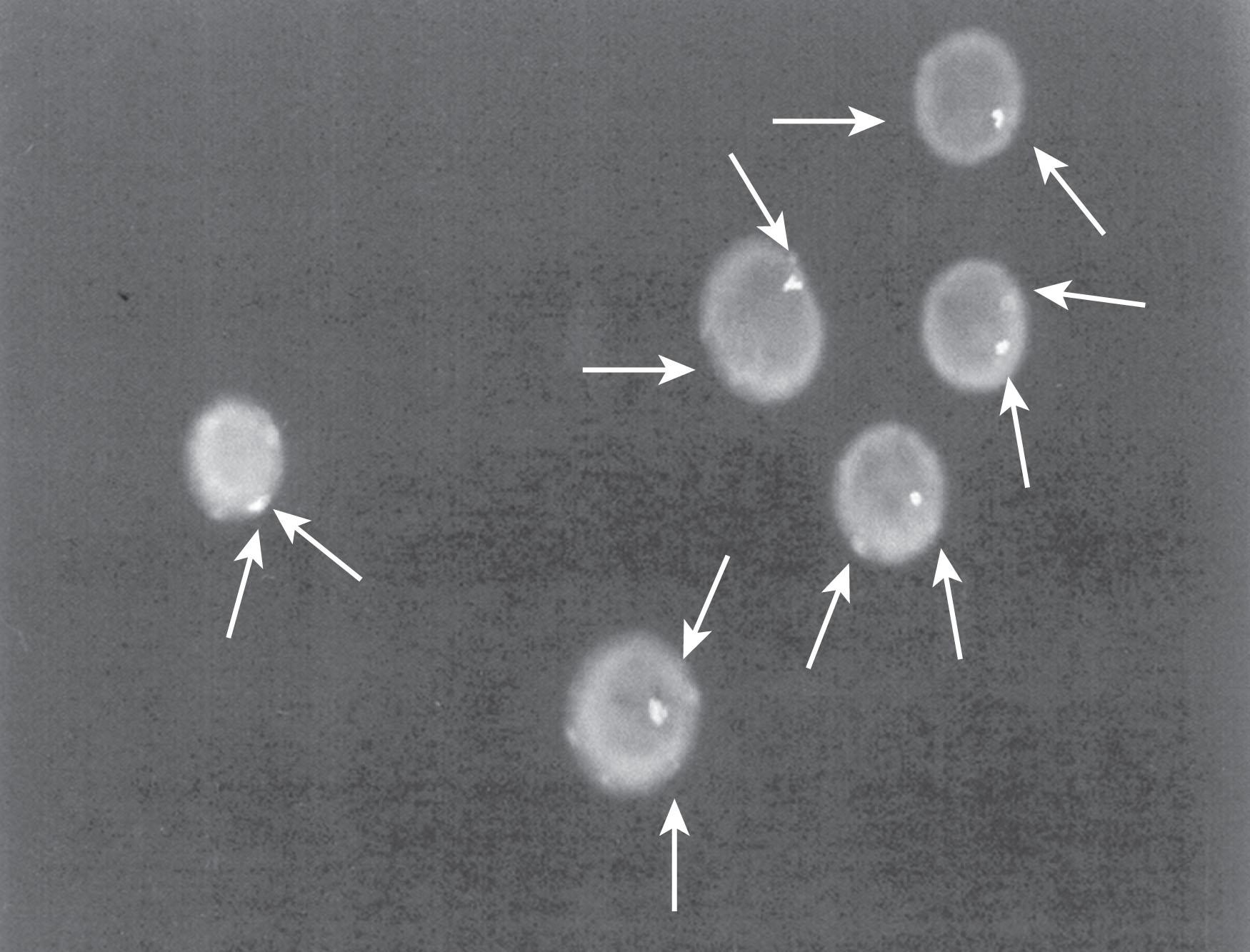
In a small percentage of ambiguous genitalia cases, laparoscopy with gonadal biopsy is necessary to confirm the diagnosis of ovotesticular DSD, gonadal dysgenesis, or Leydig cell aplasia. Obtaining a karyotype from gonadal tissue may be helpful when sex chromosome mosaicism or chimerism is suggested.
Androgenization of an XX neonate is most commonly caused by CAH, although other virilizing conditions can be involved (see Fig. 85.10 ). CAH encompasses a group of disorders of adrenal steroid hormone biosynthesis, of which more than 90% to 95% are due to 21-hydroxylase deficiency (OHD) ( Fig. 85.13 ).
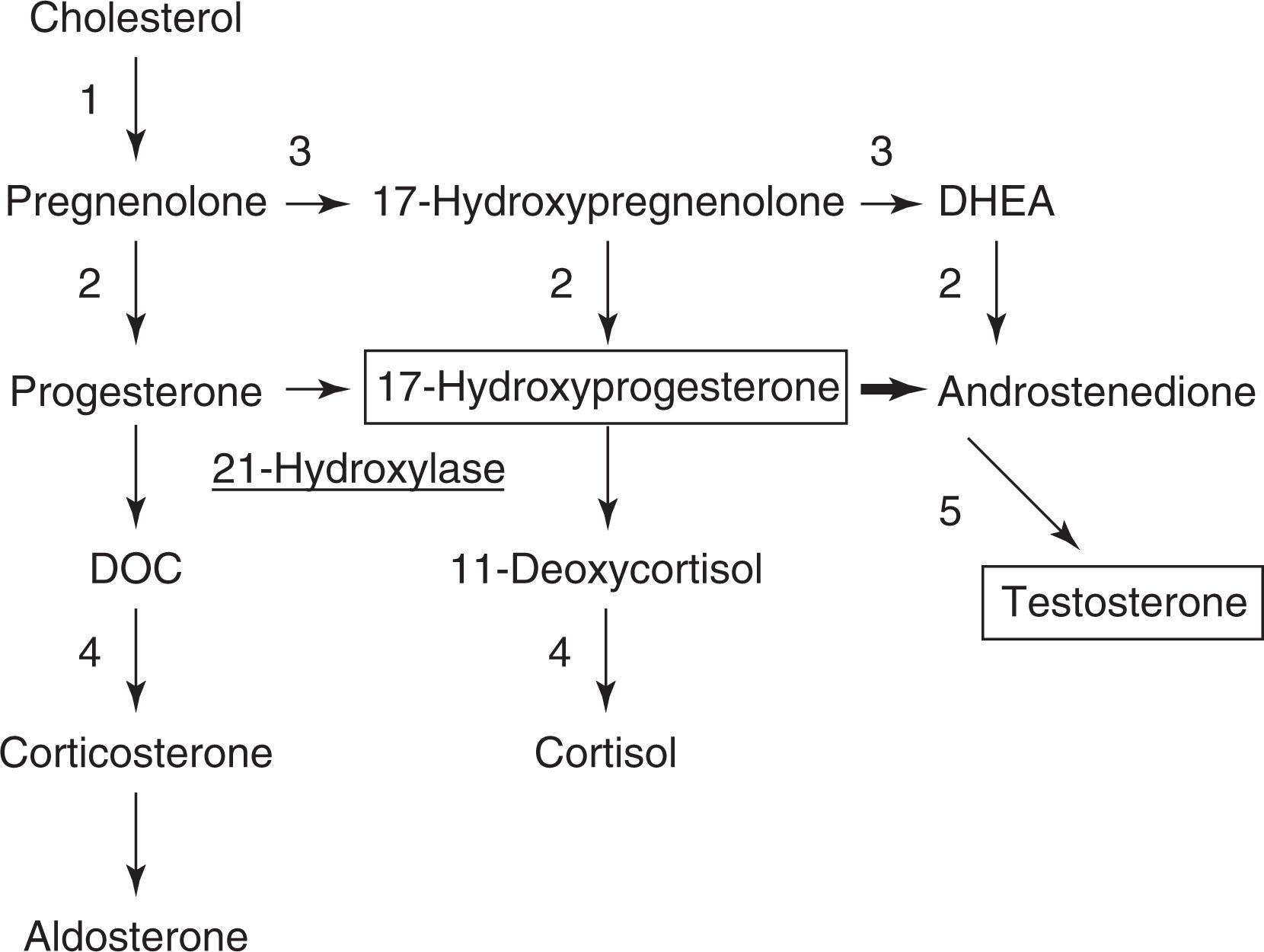
Occasionally, the presence of excess androgens of maternal origin can result in androgenization of the female fetus. A unique cause of both maternal and fetal masculinization is placental aromatase deficiency. The degree of androgenization of the external genitalia of 46,XX fetuses is dependent on the timing and magnitude of androgen exposure of the fetus. Exposure of the female fetus to high androgen levels before 12 weeks' gestation results in fusion of the labial folds, with formation of a urogenital sinus. In severely androgenized cases the external genitalia may appear completely male (see Fig. 85.6C and D ). High-level androgen exposure after 12 weeks' gestation will result in mainly clitoral hypertrophy but with separate labial folds (see Fig. 85.6A ). 46,XX testicular DSD occurs when the SRY gene is translocated from the Y chromosome to an X chromosome. Most patients with SRY -positive 46,XX testicular DSD have normal male external genitalia, but occasionally the genitalia are ambiguous.
21-OHD is the most common cause of ambiguous genitalia in the newborn female. 21-OHD has a population frequency of approximately 1 in 15,000, and the disorder is inherited in an autosomal recessive fashion. Males and females are equally affected; however, in classic cases, females have androgenization of their external genitalia at birth, resulting in the clinical presentation of ambiguous genitalia.
Deficiency of 21-hydroxylase results in excess accumulation of the substrate 17-hydroxyprogesterone (17-OHP), which is shunted into the androgen synthesizing pathway and results in excess levels of androstenedione (see Fig. 85.13 ). Androstenedione is then converted peripherally to testosterone or DHT using the backdoor pathway. The excess production of androgens results in androgenization of the external genitalia of the female fetus, whereas a male infant with 21-OHD is phenotypically normal. The degree of androgenization in the female is variable and can range from mild enlargement of the clitoris to complete fusion of the labioscrotal folds and urethral opening at the tip of the phallus (see Fig. 85.6 ). The degree of androgenization can be classified by Prader stages, ranging from I to V (see Fig. 85.3A ). Stage I represents mild enlargement of the clitoris only. Stage V represents complete androgenization of the external genitalia, with intermediate stages designating lesser degrees of involvement. The internal genitalia (ovaries, uterus, and fallopian tubes) of the females with androgenization of external genitalia are normal, however, and wolffian duct–derived structures are absent, as there was no local exposure to testosterone (see Chapter 84 for more details).
The diagnosis of 21-OHD should be suspected in all newborns with ambiguous genitalia (or clitoral hypertrophy) and absent gonads in the labial or scrotal folds. A serum 17-OHP level obtained after the first day of life will often be diagnostic. 17-OHP levels are usually 50-fold to 100-fold above the normal range in classic cases, with typical random levels of 10,000 ng/dL or higher. In some cases of 21-OHD, ACTH stimulation testing may be necessary to establish the diagnosis. If the ACTH level is already significantly elevated, however, an ACTH stimulation test will not provide additional information.
The levels of androstenedione, testosterone, 11-deoxycortisol, electrolytes, and plasma renin activity should also be determined. Plasma renin activity is a sensitive indicator of the intravascular volume status of the infant. Impaired sodium–potassium and sodium–hydrogen exchange owing to aldosterone deficiency in the distal tubule of the kidney results in hyponatremic dehydration, hyperkalemia, and metabolic acidosis.
Assessment for the less common forms of CAH resulting in ambiguous genitalia in an XX infant—11β-hydroxylase deficiency (11β-OHD), 3β-hydroxysteroid dehydrogenase (3β-HSD) deficiency, and P450 oxidoreductase deficiency—includes measurement of 11-deoxycortisol, deoxycorticosterone (DOC), DHEA and 17-hydroxypregnenolone in addition to the usual measurements of 17 OHP, androstenedione, cortisol and testosterone when evaluating for CAH. An elevated ACTH level may also be useful. Infants, though, who are stressed will have elevated ACTH and cortisol levels. Use of a comprehensive steroid panel from a reliable reference laboratory will limit the amount of blood required to 3 to 5 mL.
11β-OHD accounts for approximately 5% of CAH cases worldwide, and this disorder will also result in androgenization of the female fetus (see Fig. 85.13 ). However, the presence of volume overload and hypertension distinguishes 11β-OHD from 21-OHD. Presumably, the hypertension in 11β-OHD is caused by the excess mineralocorticoid activity of the DOC metabolite. Typically, 11-deoxycortisol level is elevated and plasma renin activity is suppressed in this disorder. However, hypertension may not present in the young infant, and thus absence of hypertension does not exclude 11β-OHD.
3β-HSD deficiency may result in ambiguous genitalia in the newborn period (see Fig. 85.13 ). Unlike 21-hydroxylase, this enzyme is present in the gonads as well as the adrenal glands, and deficiency of 3β-HSD can result in mild androgenization of the female infant and incomplete androgenization of the male infant. This enzyme deficiency also results in excess production of the steroid DHEA, which can be converted to more potent androgens peripherally. The female infant with this disorder can have clitoromegaly, although such children are often phenotypically normal. 3β-HSD is needed for testosterone biosynthesis, leading to inadequate androgenization of the male fetus. A marked increase in the ratios of 17-hydroxypregnenolone to 17-OHP and of DHEA to androstenedione is diagnostic in mutation-positive forms of this disorder.
P450 is necessary for the function of 17,20 lyase, 21 hydroxylase, and aromatase. In POR deficiency, the hormonal picture is quite mixed with partially deficient 17,20 lyase deficiency with or without 21 hydroxylase and aromatase deficiency. Sequencing of the POR gene may be necessary to determine the diagnosis. Depending on the specific mutation in POR , there may or may not be maternal virilization during the pregnancy. Maternal estriol levels may be low. XX infants may have ambiguous genitalia as well as skeletal defects associated with the Antley-Bixler syndrome.
Sex assignment for 46,XX infants with 21-OHD has traditionally been female. Gender identity of 46,XX adults with CAH is typically female, with various degrees of gender expression. Prenatal androgenization affects gender-related behavior, but not gender identity, in girls with CAH aged 5 to 12 years. Cases of gender identity disorder have been reported in treated females with CAH, and cases of gender reassignment from female to male have been reported. Individuals with undiagnosed 46,XX CAH who are profoundly virilized have functioned successfully as males which has prompted some to suggest male sex assignment in profoundly virilized 46,XX infants. However, female sex assignment is likely to prevail in current practice until evidence is obtained to indicate otherwise. 46,XX females with CAH are infertile.
In addition to medical therapies for CAH, efforts to normalize the appearance of the external genitalia may be pursued. It should be kept in mind that hypertrophy of the clitoris will gradually lessen after medical therapy is instituted; however, complete normalization in the more virilized cases is not likely to occur. In severe cases of clitoral enlargement, clitoral recession surgery is a treatment option, although suboptimal cosmetic results have been reported in long-term outcome studies. Atrophy or loss of the clitoris or excessive regrowth of clitoral tissue has been described in examinations of adolescent and adult patients who underwent genital surgery in early childhood. If CAH is not well controlled with hormonal suppression of the adrenal gland, there will be clitoral enlargement in response to the elevated testosterone levels. The risk of surgery needs to be balanced against the potential detrimental effects of masculinized genitalia on the development of a poor body image and of social stigmatization by family or community members. Nerve-sparing ventral clitoroplasty in virilized females has been shown to preserve dorsal nerves for better sensitivity after surgery.
Surgical restoration of the vagina in CAH is performed to exteriorize the vagina and to enlarge the vaginal opening so that successful intercourse can occur later in life. There is considerable debate about when to perform vaginal exteriorization surgery. A number of studies have demonstrated the development of vaginal stenosis when vaginoplasties are performed in the prepubertal period. The authors advocate delaying vaginoplasty until puberty or later, when manual dilation can be undertaken by the patient, and estrogenization of the vaginal mucosa can help to prevent stricture formation. Others recommend that vaginoplasties be undertaken early in life, because the procedure is technically easier in the first several years of life, and the emotional trauma of a major surgery in adolescence is avoided. Reports of long-term outcome of genitoplasty by patient advocate groups such as the Accord Alliance and others have called for a general moratorium on all nonessential genital surgery in infancy until affected individuals are old enough to express their wishes and give consent. Problems with loss of sexual sensation and pleasure have been reported in adult patients because of genital surgery in early life.
Androgenization of the female fetus has been reported in pregnant mothers taking various progestational agents to prevent miscarriage. These agents include norethindrone, ethisterone, and medroxyprogesterone. Danazol, which has been used in the treatment of endometriosis, has also been associated with fetal masculinization. A recent report identified retained progesterone secreting intrauterine devices during the first trimester also resulted in androgenization of the XX fetus’s external genitalia with labial fusion.
Androgenization of the female fetus because of maternal virilizing ovarian or adrenal tumors or luteomas of pregnancy has been reported. In such cases, virilization beyond the time of birth does not occur, and the prognosis is good.
Placental aromatase deficiency has been associated with androgenization of the female fetus. Aromatase is a cytochrome P450 enzyme responsible for the conversion of testosterone to estradiol and of androstenedione to estrone. Autosomal recessive inheritance of aromatase deficiency causes androgenization of the female external genitalia because of a failure to metabolize the large amounts of androstenedione and testosterone produced by the placenta. Placental aromatase deficiency will also cause significant virilization of the mother. The affected female infant will have androgenization of external genitalia with normal müllerian structures. The levels of gonadotropins are elevated in infancy, and ovarian cysts may develop. At puberty, females have hypergonadotropic hypogonadism with failure to feminize and progressive virilization. Plasma androstenedione and testosterone levels are elevated, whereas estrone and estradiol levels are low. Postpubertal individuals have delayed bone maturation, tall stature, and osteopenia.
Become a Clinical Tree membership for Full access and enjoy Unlimited articles
If you are a member. Log in here